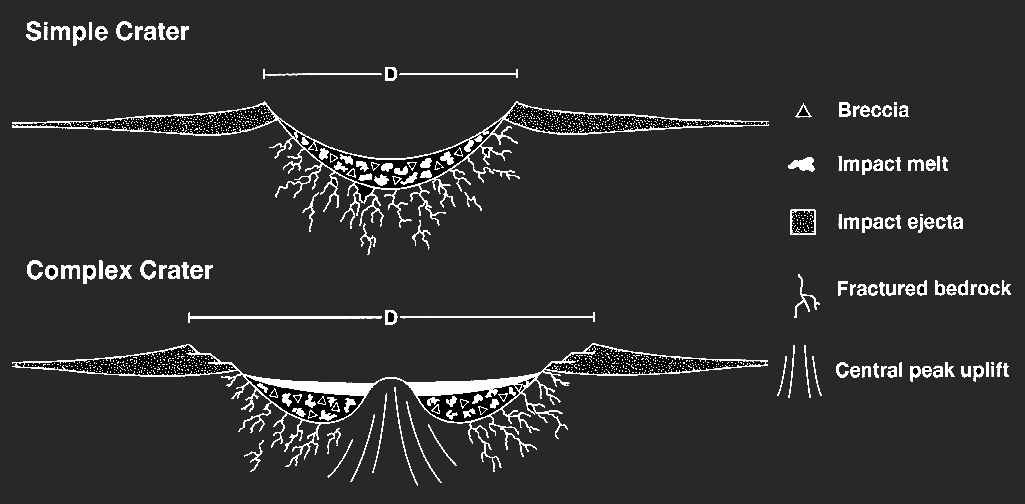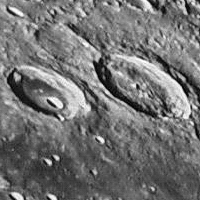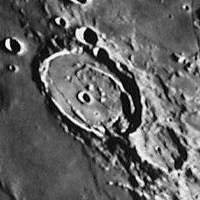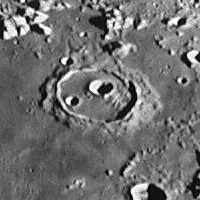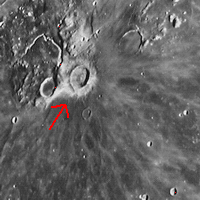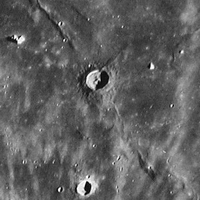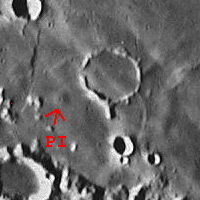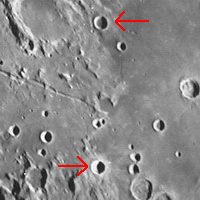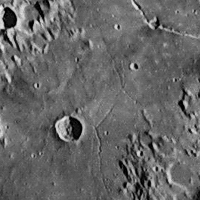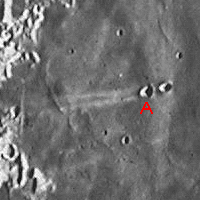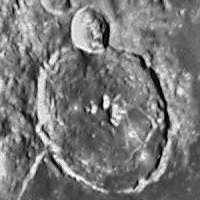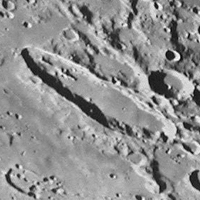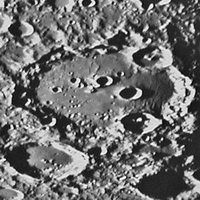|
Article 2 of 6 on Studying the Moon Observing Along the T: Fastest way to learn Features & Crater Class Michael Packer Comments: m·DOT·packer·AT·Yahoo·DOT·com |
|
“Chance
sunlight will find a fortune cookie filled with gold.”
This
witticism translates into a great night of observing if you read the last article. However, nightly observing along the terminator is by far the most economical technique for learning the moon and its wealth of
geological features. This two part article examines craters first and then
focuses on the remaining landscape. A few tips are also strewn in:
Tip
1: Observing lunar phases can be hard
to nail down for the first time. You find a feature along the terminator (T)
worth remembering, next month you look for it at the same phase (e.g. 1 day
after 1st quarter), but it doesn’t look the same or it’s gone. The problem is
not that your observation was a lucky or a rare event; you just needed to look
for it 2 months later. Here’s what’s going on. A lunar month, from new moon to
the next new moon, is about 29½ days and it turns out that the fraction ½ day
is the issue. Say you saw the feature at 10pm. So 29½ days later you would need
to look for the feature at 10am to be at the same phase. Of course that’s the
daytime so the best you can do is look hours earlier or later when it’s dark.
And doing that guarantees that you wont see the feature under the same light
and phase. But if you wait 2 months, you’ll find things are back pretty much
the way you saw them at 10pm 2 months earlier, 1 day after 1st quarter. If you
want to see the feature exactly as you saw it than you will need to
account for libration (See Article 5 of 6) by noting the solar inclination and
colongitude using VLA. With
this data, you can search for this terminator position on later dates with VMA
or other astronomy tools. Rükl’s atlas also has tables in the back.
The
above is part of the reason why there’s no field guide that faithfully represents
what you’re seeing along the T. And, over the course of a day/hour,
observations at the moons equatorial center will see the T move about
360km/15km. The latter is the width of a plethora of central peaks and small
craters. All this made for a fairly long observing curve figuring out what
you're seeing let alone creating an observing plan. The development of virtual
moon software change this situation overnight.
Tip 2: Without a doubt, the fastest way to get up to speed on what you’re
seeing through the eyepiece is to have software like VLA running next to your scope. You can
then quickly identify the craters you're observing in high relief – something
that is not swiftly done even for the seasoned observer. Also, the software's
ability to help observations at the limbs, particularly the poles, cannot be
understated.
Lastly, if you're an amateur astronomer who's just turned the telescope to the the moon, you will discover that there’s no field book that conveniently shows data that you’ve
come to expect from deep sky catalogues (in this case crater size, age
and classification). VMA provides a decent bit of this data for craters,
rilles et cetera. If you want a handy sortable catalogue, you can open the VMA file (semicolon separated)
“Nearside_Named_UK.csv” found in the Database folder using a spreadsheet. One can then
sort craters or features by age, size and class – very informative!
Crater Morphology: (Skip ahead to Craters) Observing along the T brings out crater structure fantastically - from the kenematics of impact to the erosion process that begins seconds afterword. For instance, if you examine small craters whose floors are ½ cast in shadow, you can deduce how simple or complex the shape of the crater is. And the shape properties of craters relates to impact energy. If the half shadow cast on the floor looks oval (a.
in the below figure)
 |
Most information in this section is from Planetary Science: A Lunar Perspective
and the crater is < 20 km, the crater is classed as
simple parabollic or simply bowl-shaped and lowest on the structure scale. If the
half shadow casts on the floor looks truncated/flat, this indicates a
simple crater with a little more structure (b. in above figure). In
this case the steeper bowl walls succumbed to gravity leaving a partially
filled floor with rim debris and melt rock. This is by far the most common
crater you will see in the 10-20 km range. A good example is 15km Hortensius,
in between Kepler and Reinhold. And there is a field of volcanic domes to the
north! For this level of detail, I recommend a scope of 6 inches or larger and plan your observations with the T right next to this area.
Complex
craters, on the other hand, exhibit structures such as
central peaks, inner terraced rim walls and outer
concentric faulted zones. These features along with crater size indicate a higher momemtem impact. Despite the dramatic physical differences between the
two classes, however, the final morphology of both is currently understood to be from the collapse of a geometrically simple, bowl-shaped
"transient crater" (below), which forms immediately after impact (Melosh and
Ivanov, 1999).
Development of Luner Surface Into Complex Structure From High Momemtum Impact
Initially the impact looks simple bowl-shaped but the higher momentum impact results in an even higher impact energy (Impact KE = p = ½mv2) which compresses and melts more of the underlying surface causing it to rebound leaving a central peak system. The crater wall takes on terraced structure breached by vent systems formed through weak radial facture zones or concentric faults zones.

Charles Wood and Leif Andersson further fashioned (but did not publish) simple-complex crater classification scale based on crater diameter and looks like this:
|
|||||||||
for more information.
|
||||||||||||
|
|
|
|
|
Hercules 71km & Atlas 90km |
Posidonius 99km |
Cassini 60km |
|
Colongitude 133º or 322º |
Colongitude 148º or
332º |
Colongitude 175º or
356º |
Hercules & Atlas: Both are complex craters noted by their terraced walls. But sometime after impact, magma clearly filled Hercules floor leaving only a tip of the central peak system. A subsequent impact struck the interior of this lava bed leaving a distinctive 13km simple crater. Within Atlas, magma failed to fill the crater but rather exerted pressure across the 99km plane distorting it upwards and leaving it fractured with a network of faults. This pressure also evidently eroded most of the central peak system. Look for these rilles across the floor as well as some dark areas that may hint at some magma breaching the surface.
Posidonius: Poseidon’s interior has succumbed to magma pressure both fracturing and flooding the floor. In addition, a giant section of the Northeast terraced wall and crater floor look as if they have been uplifted and pealed away from the mountain rim. Under oblique light, remnants of the central peak system looks like a massive Stonehenge.
Cassini: For purely aesthetic reasons, this is one of my favorite craters either close to or some distance off the T. Even at 150x, I see it as a triumph of modern crater architecture. Perfectly circular with perfect bowls placed within a sleek floor, it sometimes looks like a jog dial of a video editing machine.
|
|
|
|
|
Aristarchus
41km |
Lambert 31km
and Pytheas (south) |
Kies (ghost)
46km with Dome Pi |
|
Colongitude 54º or 220º |
Colongitude 25º or 198º |
Colongitude 26º or 200º |
Aristarchus: Considered the brightest of the large impact formations on the lunar surface, Aristarchus has an albedo nearly double that of most lunar features. It is bright enough to be visible to the naked eye and is also identified when illuminated by earthshine. At the T, look at the detail in its external bench of blast material to the north. It is an awesome section of scree.
Lambert: Lambert is a lone crater one often runs into while viewing the First or Last Quarter Moon. Seen within the Imbrium Sea, it is bisected by Dorsum Zirkel. The combination reveals uncluttered crater-on-mare structure near the T. Look for the southern adjacent ghost crater Lambert R and Dorsa Stille leaving Lambert to the east.
Kies: Kies is another beautiful ghost crater that reminds me of either: an island atoll in the Nubium Sea, a crop circle, or the organic chemistry symbol for benzene. What make this area significant along the T are the fantastic rilles surrounding the crater and Dome Pi to the west. The dome needs to be observed under the right lighting and with sufficient aperture to see the central crater.
|
|
|
|
|
Sosigenes 19km
& Dionysius 19km |
Triesnecker
27km |
Messier 12km
& A 13x11km |
|
Colongitude 160º or 347º |
Colongitude 157º or 0 |
Colongitude 127º or 322 |
Sosigenes and Dionysius: 19 kilometer Sosigenes is a prototypical crater that represents a transition from the simple class of impact structure to the complex and is thus worth close study near (but not at the T). South of it lies Dionysius which is likewise worth comparison some distance away from the T as well. Dionysius is a dark halo crater that ejected buried mare basalts as seen in its conspicuous ray structure. The basalt is also visible on the walls of the crater to the south and east. There is also fairly bright ejecta surrounding Dionysius indicating that bright anorthositic rock makes up part of the subsurface crust.
Triesnecker: 27 kilometer Triesnecker exhibits the first elements of complex crater structure and is thus worth study at the T. It is also surrounded with perhaps the finest network of rilles on the entire moon. The network itself, like most rilles, benefits from both oblique and high angle illumination.
Messier and Messier A: This crater duo with its beautiful ray structure disserves high angle light. But close to the T more crater structure can be seen. The grazing, near tangintal, impacts may be the result of a single body first creating Messier and its butterfly ray pattern, and then a second piece breaking off and forming Messier A and its forward ejecta rays. Chuck Wood, "A grazing impact (1° to 5°) of a projectile coming from the east excavated Messier (explaining its elongated shape and classic butterfly-wing ejecta pattern) and another part of the projectile ricocheted downrange to form Messier A and its long rays."
|
|
|
|
|
Gassendi 114km |
Schiller
179x71km |
Clavius 231km |
|
Colongitude 46º or 212º |
Colongitude 46º or 212º |
Colongitude 24º or 186º |
Gassendi: Gassendi is spectacular crater that benefits from various phases in order to study its tormented “polygonal” frame but particularly its heavily fractured and flooded floor. The entire structure has suffered more stresses than Hercules, Atlas, and even Poseidon. Perhaps such is the fate of a crater that is named after a mere mortal! But in fact it is an older crater dating back to the Nectarian Epoch. Some call it a tortoise, 33km Gassendi-A is its head, climbing onto the North shore of Mare Humorum. Look for the extensive nework of rilles (best revealed with large aperture scopes) and the extensive material debris that fills the inside of the entire arena.
Schiller: Often referred to as “Schiller's Shoe” or simply “The Shoe”, Schiller represents an outstanding oblique impact event and is likely the least circular crater on the Moon. Nearly identical impact shapes have been found on Venus and Mars and there is a shunted version of Schiller on the far side of the Moon as well. On Mars, Orcus Patera is a huge 380 x 140 km elliptical impact at 14ºN, 180ºE that is filled with mare and lacks a central peek system. Schiller’s elongated central mountain range indicates where the impactor first hit from the Northwest as it continued to plow and blow out material to Southeast. While the impact can seen in great detail under direct light, shadows cast from opposing mountain rims at the T make for a breathtaking dimensional view that is enhanced by the crater's proximity to the limb. The adjacent area South of Schiller is a rather subtle low lying plain called Schiller-Zucchius Basin.
Clavius: At 231 kilometers, Clavius is better referred to as a walled plain. The interior is covered with smooth debris from Oriental Basin (see 5/6) and of course craters that spiral in size from 50km down to 0.5km (the limit of land based images anyway) toward the center. Clavius is thus a popular target to check the resolution limits of your optics. In addition to the craters, looking for detail in the central peaks is also gratifying along with noting the sloping landscape of ejecta from Rutherfurd crater on the plain. This is a terrific sketching site!
Clavius is also the site of the moon base in the film 2001: A Space Odyssey. I mention this because it allows me to pitch the screenplay which is by far the best telling of the story and not just because it spotlights the Moon.

